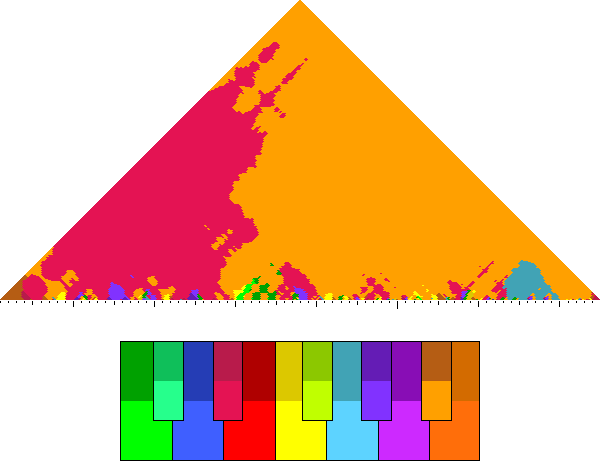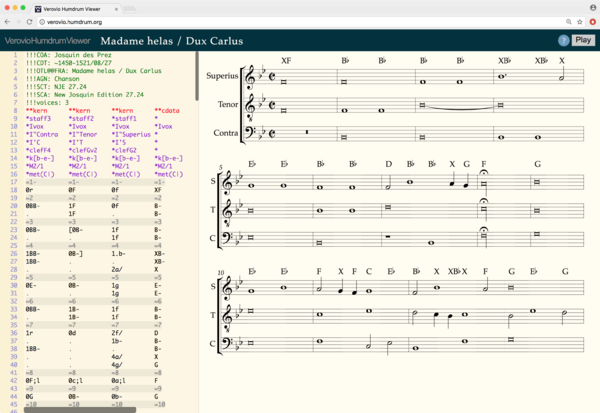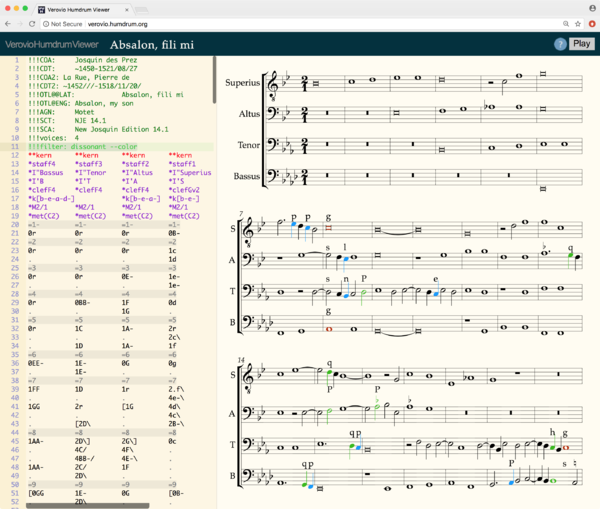Humdrum lab 4
First check out Humdrum lab 3
This lab introduces the digital scores of the Josquin Research Project.
Note in particular that the tindex/themax/theloc search engine is implemented with a front-end on the JRP website: http://josquin.stanford.edu/search
In other words, you can search entire works, although the search features are limited to 3: pitch, interval and rhythm.
Download the data
First download the data by genre:
cd ~/Desktop
mkdir jrp
cd jrp
mkdir masses
(cd masses; humsplit h://jrp/Zma)
mkdir motets
(cd motets; humsplit h://jrp/Zmo)
mkdir songs
(cd songs; humsplit h://jrp/Zso)
There are three basic genres: secular songs, religious songs (motets), and music for the mass ordinary.
You can also download works by composer, such as Jean Mouton:
humsplit h://jrp/Mou
Ockeghem:
humsplit h://jrp/Ock
Josquin securely attributed works:
humsplit h://jrp/Joa
Josquin not securely attributed works:
humsplit h://jrp/Job
All of Josquin works:
humsplit h://jrp/Jos
Alternatively, the JRP database is available on github at https://github.com/josquin-research-project/jrp-scores
How much data is there?
How many files:
cd ~/Desktop/jrp
ls masses motets songs | grep krn | wc -l
(Github is more recent).
How many notes:
cat */*.krn | extractx -i **kern | census -k
There are 803,046 notes
By genre:
for i in masses motets songs
do
echo "$i:"
cat $i/*.krn | extractx -i **kern | census -k | grep "Number of notes"
done
| Masses | 472,034 |
| Motets | 258,323 |
| Songs | 72,689 |
Longest songs:
$ scordur songs/*.krn | sort -k 2 -nr | head -n 10
songs/Jos2918-Nymphes_des_bois__Requiem.krn: 1240 songs/Jos2720-La_belle_se_siet.krn: 1192 songs/Jos2713-Helas_madame.krn: 1144 songs/Jos2723-Lheure_est_venue__Circumdederunt_me.krn: 1048 songs/Jos3009-Regretz_sans_fin.krn: 1040 songs/Jos3011-Se_congie_prens.krn: 792 songs/Jos2905-Du_mien_amant.krn: 736 songs/Ort3006-La_mi_la_sol.krn: 728 songs/Ock3012-Ma_maistresse.krn: 680 songs/Jos2811-Dulces_exuviae.krn: 680
(units of quarter notes)
Shortest masses:
$ scordur masses/*.krn | sort -k 2 -nr | tail -n 10 masses/Ock1004.3a-Missa_Cuiusvis_toni-Kyrie-on_F.krn: 316 masses/Ock1004.2a-Missa_Cuiusvis_toni-Kyrie-on_E.krn: 316 masses/Ock1004.1a-Missa_Cuiusvis_toni-Kyrie-on_D.krn: 316 masses/Ock1002a-Missa_Au_travail_suis-Kyrie.krn: 304 masses/Jos0904e-Missa_Rosina-Agnus.krn: 296 masses/Rue1005f-Missa_Ave_sanctissima_Maria-Loco_Deo_Gratias.krn: 288 masses/Jos0904d-Missa_Rosina-Sanctus.krn: 276 masses/Rue1020e-Missa_Nunca_fue_pena_mayor-Agnus.krn: 264 masses/Jos1312-Crucifixus.krn: 200 masses/Ock1001a-Kyrie_Gloria_Credo_Sine_nomine-Kyrie.krn: 144
Longest Sanctus sections of masses:
$ scordur masses/*-Sanctus.krn | sort -k 2 -nr | head -n 10 masses/Ock1003d-Missa_Caput-Sanctus.krn: 2160 masses/Ock1005d-Missa_De_plus_en_plus-Sanctus.krn: 2052 masses/Agr1004d-Missa_Malheur_me_bat-Sanctus.krn: 1968 masses/Mou1020d-Missa_Da_pacem-Sanctus.krn: 1960 masses/Jos0302d-Missa_Da_pacem-Sanctus.krn: 1960 masses/Jos0902d-Missa_Mon_seul_plaisir-Sanctus.krn: 1832 masses/Rue1031d-Missa_Tous_les_regretz-Sanctus.krn: 1808 masses/Jos1102d-Missa_La_sol_fa_re_mi-Sanctus.krn: 1728 masses/Jos0901d-Missa_Malheur_me_bat-Sanctus.krn: 1728 masses/Jos0403d-Missa_Pange_lingua-Sanctus.krn: 1708
Online census:
http://josquin.stanford.edu/census
Final tone
$ finalis songs/*.krn | sortcount 58 G 36 D 27 A 13 F 10 C 7 E 1 B-
One song with a final on B-flat.
Scale degrees
The music is not in major/minor modes as modern tonal music is conceived, so there is no key designations in the files. There is a script in Humdrum Extras which will add a key designation based on the final tone of the music so that scale degree information can be extracted from the scores:
$ finalis-tonic songs/Jos2724-Madame_helas.krn | less
Calculate scale degrees patterns of length 5 in the B-flat song:
$ finalis-tonic songs/Jos2724-Madame_helas.krn | deg -at | serialize | context -n 5 | ridx -H | sortcount 6 5 4 3 2 1 4 1 7 6 5 6 4 2 3 r 2 3 4 4 3 2 1 4 3 1 7 6 7 1 3 6 5 4 3 4 3 6 5 6 5 1 3 1 7 1 7 1 3 7 6 5 6 5 3 6 2 1 7 6
Calculate scale degrees for all songs:
$ finalis-tonic songs/Jos2724-Madame_helas.krn | deg -at | serialize \
| grep -v = | context -n 5 | ridx -H | sortcount | head -n 10
6 5 4 3 2 1
4 2 3 r 2 3
4 1 7 6 5 6
4 4 3 2 1 4
3 4 3 2 1 2
3 6 5 4 3 2
3 2 1 7 6 5
3 1 7 1 7 1
3 3 4 3 2 1
3 5 6 5 4 3
Length-5 scale degree patterns in songs:
$ finalis-tonic songs/* | extractx -i **kern | deg -at | serialize -L \
| egrep -v '=|r' | context -n 5 | ridx -H | sortcount | head -n 10
427 5 4 3- 2 1
302 3- 2 1 7- 1
297 4 3- 2 1 7-
236 2 1 7- 6 5
219 2 3- 2 1 7-
219 1 2 3- 4 5
198 7- 6 5 4 5
196 1 2 3- 2 1
193 7- 1 2 3- 2
185 1 7- 6 5 4
Exercise: How do the most common scale-degree patterns compare to masses and motets?
Keyscape
The B-flat song has an interesting harmonic structure:
$ mkeyscape -ln Jos2724-Madame_helas.krn | convert - out.png; open out.png

Stronger focus on E-flat major triads in the first part, then more B-flat major chords in the second part.
You can browse keyscapes on kernscores: http://kern.humdrum.org/cgi-bin/browse?l=/jrp
(go to analysis section of individual works and then click on the entry for keyscape)
Sonority
The Humdrum Extras tool sonority can be used for basic triadic analysis of sonorities.
$ sonority Jos2724-Madame_helas.krn | ridx -H | sortcount | head -n 10 26 X 16 incmaj:0:B- 13 incmajx3:0:B- 12 incmaj:0:E- 11 maj:0:F 10 incmin:0:D 9 maj:0:B- 8 maj:0:E- 8 note::B- 7 incmin:0:G
Only roots:
sonority -ra Jos2724-Madame_helas.krn | sed 's/qual/cdata/' | pbcopy

The "roots" of the first half of the piece:
$ myank -m 1-37 Jos2724-Madame_helas.krn | sonority | ridx -H | sortcount | head -n 10 12 X 7 maj:0:E- 6 incmajx3:0:B- 6 incmin:0:D 6 incmaj:0:E- 5 note::B- 5 maj:0:F 4 incmaj:0:B- 4 incmin:0:G 4 min:0:C
The "roots" of the second half of the piece:
$ myank -m 38-$ Jos2724-Madame_helas.krn | sonority | ridx -H | sortcount | head -n 10 14 X 12 incmaj:0:B- 7 maj:0:B- 7 incmajx3:0:B- 6 maj:0:F 6 incmaj:0:E- 6 incmaj:1:E- 5 maj:1:F 4 incmin:0:D 4 note::F
Generalized sonorities
The Humdrum Extras tntype tool gives a generalized description of the sonorities.
First look at the notes that are present at each time position in the score:
tntype -da Jos2724-Madame_helas.krn | less
Then look at the sonorities in compact pitch class form:
tntype -tna Jos2724-Madame_helas.krn | tntype -da
Then look at the sonorities as a Forte enumeration:
tntype -a Jos2724-Madame_helas.krn | tntype -tna | tntype -da
=1- =1- =1- =1- =1- =1- 0r 0F 0f 1-1 [5] F =2 =2 =2 =2 =2 =2 0BB- 1F 0f 2-5 [5A] B- f . 1F . 2-5 [5A] (B-) f =3 =3 =3 =3 =3 =3 0BB- [0B- 1f 2-5 [5A] B- f . . 1f 2-5 [5A] (B-) f =4 =4 =4 =4 =4 =4 1BB- 0B-] 1.b- 1-1 [A] B- 1BB- . . 1-1 [A] B- . . 2a/ 2-1 [9A] a (B-) =5 =5 =5 =5 =5 =5
Forte number 3-11A is a minor chord, and 3-11B is a major chord.
There are 351 chord "prototypes" (uniq transposable sets of 1 to 12 notes): https://www.scribd.com/document/237597049/Table-of-Pitch-Class-Sets
What are the generalized sonorities of the Motet genre:
$ tntype * | ridx -H | sortcount -p | head -n 10 18.31 3-11B 17.68 3-11A 13.01 2-3 11.05 2-5 9.92 2-4 6.23 1-1 3.92 3-9 2.47 2-2 2.01 3-7A 1.93 3-10
18.31% of the sonorities are major triads, and 17.68% are minor triads. The next most common 3-note chord type is 3-9 which is a chord such as "C F G", 3-7A is a sonority such as "C D F", and 3-19 is a diminished triad such as "C E-flat G-flat".
Compare to Bach chorale sonorities:
$ tntype ~/Desktop/chorales/*.krn | ridx -H | sortcount -p | head -n 10 35.09 3-11B 17.26 3-11A 9.07 4-27B 4.96 4-26 4.36 3-10 4.26 3-9 2.8 4-20 2.52 4-27A 1.99 4-22A 1.95 3-7A
Major triads are twice as more likely in Bach chorales than minor triads (particularly because there are more chorales in major keys -- try analyzing major an minor separately).
Contextual analysis of sonorities
What chord types follow a 3-9 sonority in JRP Motets?
$ tntype *.krn | grep -v = | context -n 2 | grep ^3-9 | sortcount -p | head -n 10 47.44 3-9 3-11B 18.25 3-9 3-11A 14.31 3-9 2-5 4.41 3-9 2-3 3.8 3-9 2-4 2.81 3-9 3-10 1.95 3-9 3-9 1.61 3-9 4-23 1.08 3-9 3-7A 0.81 3-9 1-1
Mostly 3-9 is going to 3-11B (major triad), then secondly to minor triad at 18.25%.
Compare to Bach chorales:
$ tntype ~/Desktop/chorales/*.krn | grep -v = | context -n 2 | grep ^3-9 | sortcount -p | head -n 10 57.36 3-9 3-11B 11.01 3-9 3-11A 6.36 3-9 3-9 5.89 3-9 4-27B 4.65 3-9 2-5 3.95 3-9 4-23 1.94 3-9 4-26 1.86 3-9 3-8A 0.85 3-9 4-27A 0.85 3-9 2-4
Still mostly going to major sonorities.
What sonorities precede a 3-9 sonority:
$ tntype ~/Desktop/chorales/*.krn | grep -v = | context -n 2 | grep 3-9$ | sortcount -p | head -n 10 34.73 3-11B 3-9 21.01 3-11A 3-9 6.36 3-9 3-9 5.35 4-14B 3-9 4.65 4-22B 3-9 3.49 4-27B 3-9 2.64 4-26 3-9 2.33 4-20 3-9 2.17 4-27A 3-9 1.94 2-5 3-9
Usually a major sonority precedes a 3-9 sonority.
What about both before and after at the same time:
$ tntype ~/Desktop/chorales/*.krn | grep -v = | context -n 3 | grep " 3-9 " | sortcount -p | head -n 10 23.1 3-11B 3-9 3-11B 7.05 3-11A 3-9 3-11B 5.5 3-11A 3-9 3-11A 4.57 3-9 3-9 3-11B 3.02 4-14B 3-9 3-11B 2.71 3-11B 3-9 3-9 2.4 4-22B 3-9 3-11B 2.25 4-27B 3-9 3-11B 1.86 3-11B 3-9 4-27B 1.86 4-20 3-9 3-11B
Most often a 3-11B goes to 3-9 goes to 3-11B. Second most common is minor to 3-9 to major, then minor to 3-9 to minor.
dissonant
The dissonant humlib tool was developed by Alex Morgan last year. This tool does two things: (1) identifies dissonances in the music (easy), and (2) labels the function of the dissonance (hard).
Try loading some JRP scores into the VHV editor, and type a line somewhere in the editor:
!!!filter: dissonant --color
You should see some text labels and colored notes that are dissonant:

What are the most common dissonance types in the JRP songs:
$ dissonant *.krn | extractx -i **cdata | serialize | ridx -H \
| sortcount -p | head -n 10
25.07 g
18.36 p
17.15 P
13.91 s
6.3 q
5.68 n
1.37 v
1.28 e
1.27 a
1.25 k
1.21 h
0.95 c
0.79 Z
In the masses:
$ dissonant ../masses/*.krn | extractx -i **cdata | serialize | ridx -H \
| sortcount -p | head -n 10
22.19 g
17.68 p
17.55 P
13.78 s
6.63 q
4.64 n
2.02 v
1.97 k
1.69 c
1.51 a
| Lab 1 (intro) | Lab 2 (Essen) | Lab 3 (searching) | Lab 4 (JRP) | Lab 5 (Wikifonia) | Lab 6 (bar chart) | Lab 7 (regular expressions) | Lab 8 (chorck & cint) |